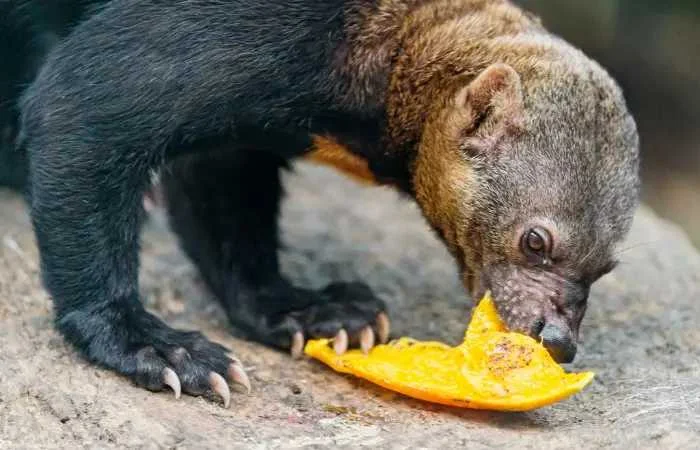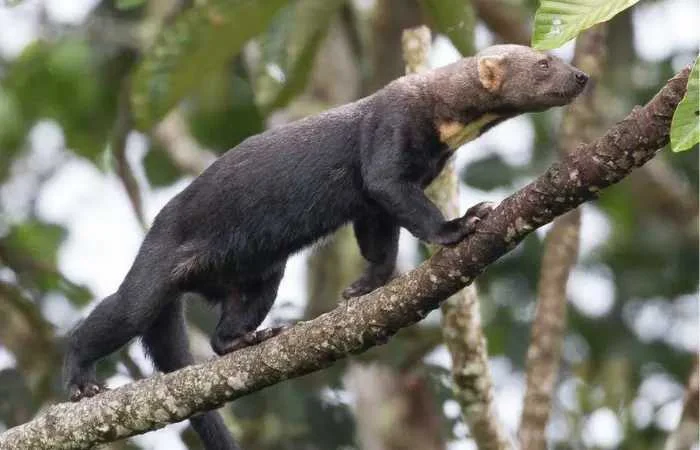Tayra - An Incredible yet Lesser Known Mustelid
Tayra
( Eira barbara )
Scientific classification
Kingdom:
Animalia
Phylum:
Chordata
Class:
Mammalia
Order:
Carnivora
Family:
Mustelidae
Genus:
Eira
Hamilton Smith, 1842
Species:
E. barbara
| Scientific classification | |
|---|---|
| Kingdom: | Animalia |
| Phylum: | Chordata |
| Class: | Mammalia |
| Order: | Carnivora |
| Family: | Mustelidae |
| Genus: | Eira
Hamilton Smith, 1842 |
| Species: | E. barbara |
The tayra (Eira barbara) is an omnivorous animal from the weasel (mustelid) family, native to the Americas. It is the sole species in the genus Eira. Tayras are also known as the tolomuco or perico ligero in Central America, the motete in Honduras, the irara in Brazil, the san hol or viejo de monte in the Yucatan Peninsula, and the high-woods dog (or traditionally chien bois) in Trinidad. The genus name Eira is taken from the animal's traditional name in Bolivia and Peru, whilst Barbara means "strange" or "foreign".
Tayras are long, agile mustelids, similar in appearance to a large fisher or marten, but slightly more reminiscent of a sleeker, smaller wolverine. They typically measure between 56 to 71 cm (22 to 28 in) in length, excluding their 37- to 46-cm-long (15 to 18 in) bushy tail, and weigh in the range of 2.7 to 7.0 kg (6.0 to 15.4 lb). Males tend to be larger and more muscular than females. Their fur is short and ranges from dark brown to black, with a relatively consistent length and color across the body, limbs, and tail, except for a distinctive yellowish or orange "heart"-shaped patch on the chest. Each tayra's chest marking is unique in color, shape, and size, which aids biologists, rescuers, and specialists in individual identification. The fur on their head and neck is lighter, often tan or greyish in color. Additionally, albino, white, or beige-yellow individuals are known to exist, with genetic color variations being more common in tayras compared to other mustelids.
The feet have toes of unequal length with tips that form a strongly curved line when held together. The claws are short and curved, but strong, being adapted for climbing and running rather than digging. The pads of the feet are hairless, but are surrounded by stiff sensory hairs. The head showcases small, rounded ears, long sensory whiskers, and black eyes with a captivating blue-green gleam. Like other musteloids, tayras possess anal scent glands, albeit not nearly as large or pungent in odor as in other species. Moreover, tayras typically utilize scent-marking for territorial demarcation and identifying other animals in the vicinity, rather than employing it as a self-defense tactic, as with skunks.
Currently, seven regional subspecies (click to view)
of Tayras are recognised.
Currently, seven regional subspecies (click to view)
Tayras inhabit most of South America, except for Chile, Uruguay, Argentina (except the far northern regions), and parts of the Brazilian east coast. They are distributed throughout Central America, with their habitat extending from México—including regions as far north as Tamaulipas and Veracruz on the east coast, and south to Sinaloa and Nayarit on the west coast—continuing southwards to Panamá. Tayras are also present on the island of Trinidad.
They typically inhabit tropical and subtropical forests; however, they may also cross grasslands or other environments at night as they travel between forested areas. Additionally, they are observed in cultivated areas, tree plantations, and farmlands.
Diet

They are opportunistic omnivores, preying on rodents and other small mammals, as well as birds, lizards, other reptiles, and invertebrates, and climbing trees to obtain fruit and honey. They locate prey primarily by scent, having relatively poor eyesight, and actively chase it once located, rather than stalking or using ambush tactics. An interesting instance of caching has been observed among tayras: a tayra will select unripe green plantains, which are inedible, and leave them to ripen in a cache, returning a few days later to consume the softened pulp.
Behavior & Reproduction

Tayras are diurnal animals, although occasionally active during the evening or at night. The social behavior of tayras is not well understood. Often considered solitary, they have been seen in larger groups, presumably consisting of a mother and her older offspring. They are adept climbers, utilizing their long tails for balance. On the ground or on large horizontal tree limbs, they use a bounding gallop when moving at high speeds. They can also leap from treetop to treetop when pursued. They generally avoid water but are capable of swimming across rivers when necessary.
They inhabit hollow trees or burrows in the ground. Individual animals maintain relatively large home ranges, with areas up to 24 km2 (9.3 sq mi) having been recorded. They may travel at least 6 km (3.7 mi) in a single night. Tayras breed year-round, with females entering estrus several times each year for 3 to 20 days at a time. Unlike some other mustelids, tayras do not exhibit embryonic diapause, and gestation lasts from 63 to 67 days. The female gives birth to one to three young, which she cares for alone.
The young are altricial, being born blind and with closed ears, but are already covered in a full coat of black fur; they weigh about 100 g (3.5 oz) at birth. Their eyes open at 35 to 47 days, and they leave the den shortly thereafter. They begin to consume solid food around 70 days of age and are fully weaned by 100 days. Hunting behavior begins as early as three months, and the mother initially brings her young wounded or slow prey to practice on as they improve their killing technique. The young are fully grown around 6 months old and leave their mother to establish their own territory by 10 months.
There is limited information about levels of off-take of the species. Schreiber et al. (1989) suggested that its habitat has been reduced in parts of Mexico due to the destruction of tropical forests and expansion of agriculture. Tayras are targeted for hunting for their fur and are frequently victims of road accidents in many South American countries.
Tayras are classified as Least Concern because, although they are likely locally threatened due to human activity (Nowak 2005), and even though current threats are decreasing their populations, they are still considered locally abundant throughout their entire range and inhabit a variety of natural and disturbed habitats.
References
- Cuarón, A.D.; Reid, F.; Helgen, K.; González-Maya, J.F. (2016). "Eira barbara". IUCN Red List of Threatened Species. 2016: e.T41644A45212151. doi:10.2305/IUCN.UK.2016-1.RLTS.T41644A45212151.en. Retrived on April 20, 2024, from https://dx.doi.org/10.2305/IUCN.UK.2016-1.RLTS.T41644A45212151.en .
- Steven J. Presley "Eira barbara," Mammalian Species 2000(636), 1-6, (12 May 2000). https://doi.org/10.1644/1545-1410(2000)636...2.0.CO;2
Retrived on April 21, 2024, from https://doi.org/10.1644/1545-1410(2000)636...2.0.CO;2.
- Presley, S.J. (2000). "Eira barbara" (PDF). Mammalian Species. 636: 1–6. doi:10.1644/1545-1410(2000)636<
0001:eb>2.0.co;2.
Retrived on April 21, 2024, from https://doi.org/10.1644/1545-1410(2000)636<0001:eb>2.0.CO;2 .
- Villafañe-Trujillo, Álvaro José; López-González, Carlos Alberto; Kolowski, Joseph M. (2018-01-24). "Throat patch variation in tayra (Eira barbara) and the potential for individual identification in the field". Diversity. 10 (1): 7. doi:10.3390/d10010007.
Retrived on April 21, 2024, from https://doi.org/10.3390/d10010007.
- Defler, T.R. (1980). "Notes on interactions between tayra (Eira barbara) and the white-fronted capuchin (Cebus albifrons)". Journal of Mammalogy. 61 (1): 156. doi:10.2307/1379979. JSTOR 1379979.
Retrived on April 21, 2024, from https://doi.org/10.2307/1379979.
- Tayra (Eira barbara). (n.d.). iNaturalist. https://www.inaturalist.org/taxa/41774-Eira-barbara.
Retrived on April 21, 2024, from https://www.inaturalist.org/taxa/41774-Eira-barbara.
- Kavanau, J.L. (1971). "Locomotion and activity phasing of some medium-sized mammals". Journal of Mammalogy. 52 (2): 396–403. doi:10.2307/1378681. JSTOR 1378681.
Retrived on April 21, 2024, from https://doi.org/10.2307/1379979.
- Soley, F.G. & Alvarado-Díaz, I. (8 July 2011). "Prospective thinking in a mustelid? Eira barbara (Carnivora) cache unripe fruits to consume them once ripened". Naturwissenschaften. 98 (8): 693–698. Bibcode:2011NW.....98..693S. doi:10.1007/s00114-011-0821-0. PMID 21739130. S2CID 6205887.
Retrived on April 21, 2024, from https://doi.org/10.1007/s00114-011-0821-0.
- Vaughan, R. (1974). "Breeding the tayra (Eira barbara) at Antelope Zoo, Lincoln". International Zoo Yearbook. 14: 120–122. doi:10.1111/j.1748-1090.1974.tb00791.x.
Retrived on April 21, 2024, from https://doi.org/10.1111/j.1748-1090.1974.tb00791.x.





.webp)
.webp)

Comments
Post a Comment